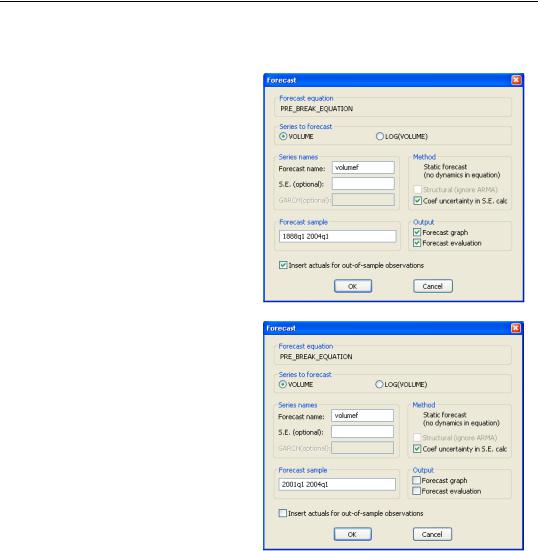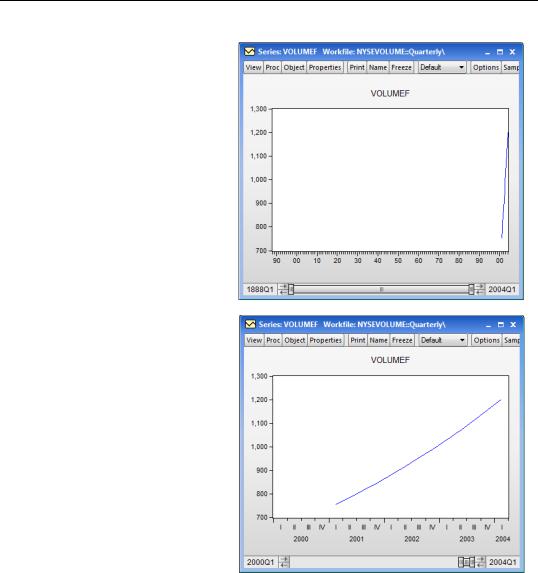
- •Table of Contents
- •Foreword
- •Chapter 1. A Quick Walk Through
- •Workfile: The Basic EViews Document
- •Viewing an individual series
- •Looking at different samples
- •Generating a new series
- •Looking at a pair of series together
- •Estimating your first regression in EViews
- •Saving your work
- •Forecasting
- •What’s Ahead
- •Chapter 2. EViews—Meet Data
- •The Structure of Data and the Structure of a Workfile
- •Creating a New Workfile
- •Deconstructing the Workfile
- •Time to Type
- •Identity Noncrisis
- •Dated Series
- •The Import Business
- •Adding Data To An Existing Workfile—Or, Being Rectangular Doesn’t Mean Being Inflexible
- •Among the Missing
- •Quick Review
- •Appendix: Having A Good Time With Your Date
- •Chapter 3. Getting the Most from Least Squares
- •A First Regression
- •The Really Important Regression Results
- •The Pretty Important (But Not So Important As the Last Section’s) Regression Results
- •A Multiple Regression Is Simple Too
- •Hypothesis Testing
- •Representing
- •What’s Left After You’ve Gotten the Most Out of Least Squares
- •Quick Review
- •Chapter 4. Data—The Transformational Experience
- •Your Basic Elementary Algebra
- •Simple Sample Says
- •Data Types Plain and Fancy
- •Numbers and Letters
- •Can We Have A Date?
- •What Are Your Values?
- •Relative Exotica
- •Quick Review
- •Chapter 5. Picture This!
- •A Simple Soup-To-Nuts Graphing Example
- •A Graphic Description of the Creative Process
- •Picture One Series
- •Group Graphics
- •Let’s Look At This From Another Angle
- •To Summarize
- •Categorical Graphs
- •Togetherness of the Second Sort
- •Quick Review and Look Ahead
- •Chapter 6. Intimacy With Graphic Objects
- •To Freeze Or Not To Freeze Redux
- •A Touch of Text
- •Shady Areas and No-Worry Lines
- •Templates for Success
- •Point Me The Way
- •Your Data Another Sorta Way
- •Give A Graph A Fair Break
- •Options, Options, Options
- •Quick Review?
- •Chapter 7. Look At Your Data
- •Sorting Things Out
- •Describing Series—Just The Facts Please
- •Describing Series—Picturing the Distribution
- •Tests On Series
- •Describing Groups—Just the Facts—Putting It Together
- •Chapter 8. Forecasting
- •Just Push the Forecast Button
- •Theory of Forecasting
- •Dynamic Versus Static Forecasting
- •Sample Forecast Samples
- •Facing the Unknown
- •Forecast Evaluation
- •Forecasting Beneath the Surface
- •Quick Review—Forecasting
- •Chapter 9. Page After Page After Page
- •Pages Are Easy To Reach
- •Creating New Pages
- •Renaming, Deleting, and Saving Pages
- •Multi-Page Workfiles—The Most Basic Motivation
- •Multiple Frequencies—Multiple Pages
- •Links—The Live Connection
- •Unlinking
- •Have A Match?
- •Matching When The Identifiers Are Really Different
- •Contracted Data
- •Expanded Data
- •Having Contractions
- •Two Hints and A GotchYa
- •Quick Review
- •Chapter 10. Prelude to Panel and Pool
- •Pooled or Paneled Population
- •Nuances
- •So What Are the Benefits of Using Pools and Panels?
- •Quick (P)review
- •Chapter 11. Panel—What’s My Line?
- •What’s So Nifty About Panel Data?
- •Setting Up Panel Data
- •Panel Estimation
- •Pretty Panel Pictures
- •More Panel Estimation Techniques
- •One Dimensional Two-Dimensional Panels
- •Fixed Effects With and Without the Social Contrivance of Panel Structure
- •Quick Review—Panel
- •Chapter 12. Everyone Into the Pool
- •Getting Your Feet Wet
- •Playing in the Pool—Data
- •Getting Out of the Pool
- •More Pool Estimation
- •Getting Data In and Out of the Pool
- •Quick Review—Pools
- •Chapter 13. Serial Correlation—Friend or Foe?
- •Visual Checks
- •Testing for Serial Correlation
- •More General Patterns of Serial Correlation
- •Correcting for Serial Correlation
- •Forecasting
- •ARMA and ARIMA Models
- •Quick Review
- •Chapter 14. A Taste of Advanced Estimation
- •Weighted Least Squares
- •Heteroskedasticity
- •Nonlinear Least Squares
- •Generalized Method of Moments
- •Limited Dependent Variables
- •ARCH, etc.
- •Maximum Likelihood—Rolling Your Own
- •System Estimation
- •Vector Autoregressions—VAR
- •Quick Review?
- •Chapter 15. Super Models
- •Your First Homework—Bam, Taken Up A Notch!
- •Looking At Model Solutions
- •More Model Information
- •Your Second Homework
- •Simulating VARs
- •Rich Super Models
- •Quick Review
- •Chapter 16. Get With the Program
- •I Want To Do It Over and Over Again
- •You Want To Have An Argument
- •Program Variables
- •Loopy
- •Other Program Controls
- •A Rolling Example
- •Quick Review
- •Appendix: Sample Programs
- •Chapter 17. Odds and Ends
- •How Much Data Can EViews Handle?
- •How Long Does It Take To Compute An Estimate?
- •Freeze!
- •A Comment On Tables
- •Saving Tables and Almost Tables
- •Saving Graphs and Almost Graphs
- •Unsubtle Redirection
- •Objects and Commands
- •Workfile Backups
- •Updates—A Small Thing
- •Updates—A Big Thing
- •Ready To Take A Break?
- •Help!
- •Odd Ending
- •Chapter 18. Optional Ending
- •Required Options
- •Option-al Recommendations
- •More Detailed Options
- •Window Behavior
- •Font Options
- •Frequency Conversion
- •Alpha Truncation
- •Spreadsheet Defaults
- •Workfile Storage Defaults
- •Estimation Defaults
- •File Locations
- •Graphics Defaults
- •Quick Review
- •Index
- •Symbols

18—Chapter 1. A Quick Walk Through
Saving your work
Quite satisfactory, but this is getting to be thirsty work. Before we take a break, let’s save our equation in the workfile. Hit the  button on the equation window. In the upper field type a meaningful name.
button on the equation window. In the upper field type a meaningful name.
Hint: Spaces aren’t allowed when naming an object in EViews.
Prior to this step the title bar of the equation window read “Equation: untitled.” Using the  button changed two things: the equation now has a name which appears in the title bar, and more importantly, the equation object is stored in the workfile. You can see these
button changed two things: the equation now has a name which appears in the title bar, and more importantly, the equation object is stored in the workfile. You can see these
changes below. If you like, close the equation window and then double-click on  to re-open the equation. But don’t take the break quite yet!
to re-open the equation. But don’t take the break quite yet!

Saving your work—19
Before leaving the computer, click on the workfile window. Use the File menu choice File/Save As… to save the workfile on the disk.
Now would be a good time to take a break. In fact, take a few minutes and indulge in your favorite beverage.
Back so soon? If your computer froze while you were gone you can start up EViews and use File/Open/EViews Workfile… to reload the workfile you saved before the break.
Your computer didn’t freeze, did it? (But then, you probably didn’t really take a break either.) This is the spot in which authors enjoin you to save your work often. The truth is, EViews is remarkably stable software. It certainly crashes less often than your typical word processor. So, yes, you should save your workfile to disk as a safety measure since it’s easy, but there’s a different reason that we’re emphasizing saving your workfile.
EViews doesn’t have an Undo feature.
As you work you make changes to the data in the workfile. Sometimes you find you’ve gone up a blind alley and would like to back out. Since there is no Undo feature, we have to substitute by doing Save As… frequently. If you like, save files as “foo1.wf1”, “foo2.wf1”, etc. If you find you’ve made changes to the workfile in memory that you now regret you can “backup” by loading in “foo1.wf1”.
You can also hit the Save button on the workfile window to save a copy of the workfile to disk. This is a few keystrokes easier than Save As…. But while Save protects you from computer failure, it doesn’t substitute for an Undo feature. Instead it copies the current workfile in memory—including all the changes you’ve made—on top of the version stored on disk.
Pedantic note: EViews does have an Undo item in the usual place on the Edit menu. It works when you’re typing text. It doesn’t Undo changes to the workfile.

20—Chapter 1. A Quick Walk Through
Forecasting
We have a regression equation that
gives a good explanation of
log(volume) . Let’s use this equation to forecast NYSE volume. Hit the
 button on the equation window to open the forecast dialog.
button on the equation window to open the forecast dialog.
Notice that we have a choice of fore-
casting either volume or
log(volume) . (When you use a function as a dependent variable, EViews offers the choice of forecasting either the function or the underlying variable.) The one we actually care about is volume—taking logs was just a trick to get a better statistical model. Leave the dialog set to forecast volume. Uncheck Forecast graph, Forecast evaluation, and Insert actuals for out-of-sample observations. In the Forecast sample field enter “2001q1 2004q1”. Your dialog should look something like the one shown.

What’s Ahead—21
EViews creates a series of forecast values for volume, storing them in the series VOLUMEF, which now appears in the workfile window. Double-click on  . Choose
. Choose
View/Graph... in the VOLUMEF window and select Line in the dialog to see the forecast values.
The first thing you’ll notice is that nothing shows up on most of the plot. We asked EViews to start the forecast in January 2001 and that’s what EViews did, so there is no forecast for most of our historical period. Click the  button and enter “2000 @LAST” in the upper field of the Sample dialog. Alternately, use the slider bar to set the sample from 2000q1 to 2004q1. The graph snaps to a close up view of the last few years.
button and enter “2000 @LAST” in the upper field of the Sample dialog. Alternately, use the slider bar to set the sample from 2000q1 to 2004q1. The graph snaps to a close up view of the last few years.
You have a volume forecast. NYSE volume is forecast to rise over the forecast period from
about 750 million shares to nearly 1.2 billion. Mission accomplished.
What’s Ahead
This chapter’s been a quick stroll through EViews, just enough—we hope—to whet your appetite. You can continue walking through the chapters in order, but skipping around is fine too. If you’ll be mostly using EViews files prepared by others, you might proceed to Chapter 3, “Getting the Most from Least Squares,” to dive right into regressions; to

22—Chapter 1. A Quick Walk Through
Chapter 7, “Look At Your Data,” for both simple and advanced techniques for describing your data, or to Chapter 5, “Picture This!,” if it’s graphs and plots you’re after. If you like the more orderly approach, continue on to the next chapter where we’ll start the adventure of setting up your own workfile and entering your own data.
Now it’s time to take a break for real.
